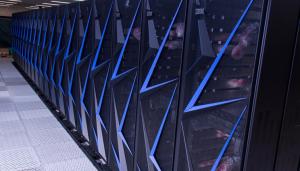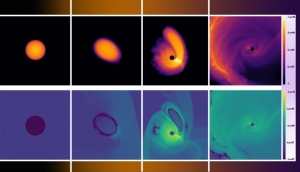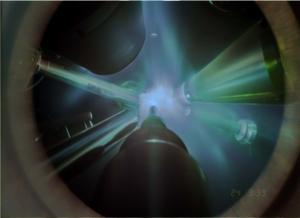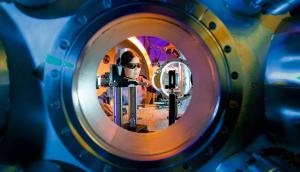LAB REPORT
Science and Technology Making Headlines
Nov. 2, 2018


Sierra, one of the fastest supercomputers in the world, will serve the National Nuclear Security Administration’s three nuclear security laboratories, providing high-fidelity simulations. Photo by Randy Wong/LLNL
Unveiling a mini city of processing power
Covering 7,000 square feet and with 240 computing racks and 4,320 nodes, Lawrence Livermore holds what looks like a futuristic mini city of black boxes with flashing blue and green lights.
This buzzing machine, called Sierra, is the third most powerful computer in the world. It was unveiled last week at its home at LLNL, after four years in the making.
At its peak, Sierra can do 125 quadrillion calculations in a second. Its simulations are 100,000 times more realistic than anything a normal desktop computer can make. The only two supercomputers that are more powerful are China's Sunway Taihulight in second place and Oak Ridge National Laboatory's Summit in first.
Powering such a massive electronic brain takes about 11 to 12 megawatts of energy, roughly the equivalent of what's needed to power 12,000 homes — a relatively energy-efficient level of consumption, according to Sierra's developers.


Supercomputer simulations show the evolution of a dormant white dwarf star reigniting as it whizzes around an intermediate-mass black hole. The top series of images show density, the bottom show temperature.
Zombie stars return from the dead
A dormant white dwarf star has returned from the dead. Research out of Lawrence Livermore National Laboratory suggests the remnant cores of burned-out stars (such as the white dwarf) could be the key to making the first observation of the most elusive class of black holes.
The research explored whether a dormant white dwarf star — sometimes referred to as a "zombie" star — could reignite if it had a close encounter with an intermediate-mass black hole. While data exists to corroborate the existence of supermassive black holes, there have been no confirmed observations of black holes in the intermediate class, which range in size from 100 to 100,000 solar masses. This intermediate class, the research team posited, might offer just the right amount of gravitational force to reignite a white dwarf before it's torn apart.
The team ran supercomputer simulations of dozens of different close encounter scenarios to test this theory. Not only did they find that a close encounter would reignite the once-dead star, but they saw evidence that the process could create significant electromagnetic and gravitational wave energies that might be visible from detectors in near-Earth orbit.


Computer simulation showing water molecules ordering to form ice VII.
As cold as ice
New LLNL research suggests that an exotic phase of water, known as “ice VII” could grow at rates exceeding 1,000 miles per hour under the atmospheric conditions found on alien ocean worlds.
Water exists in three main phases (solid, liquid and gas) and the phase it occupies is a function of atmospheric pressure and temperature. The solid form of water — ice — has several phases of its own, however most of them exist at extremely low temperatures (but some of them can exist at temperatures upward of 1300 degrees Fahrenheit so long as the pressure is high enough).
Theorists at Lawrence Livermore have demonstrated how water transitions to ice VII, a process known as “nucleation,” which helps explain how this exotic phase of ice forms on alien ocean planets.


Electric fields assemble silver nanocrystals into a superlattice. Image by Jacob Long/LLNL
Nanocrystals make arrangements
Lawrence Livermore researchers are working to make better electronic devices by delving into the way nanocrystals are arranged.
Nanocrystals are promising building blocks for new and improved electronic devices, due to their size-tunable properties and ability to integrate into devices at low-cost. While the structure of nanocrystals has been extensively studied, no one has been able to watch the full assembly process.
That’s where LLNL scientists Christine Orme, Yixuan Yu, Babak Sadigh and a colleague from the University of California, Los Angeles come in.
‘We think the situation can be improved if detailed quantitative information on the nanocrystal assembly process could be identified and if the crystallization process were better controlled,” says Orme, an LLNL material scientist.


Hui Chen looks through the Titan target chamber at LLNL’s Jupiter Laser Facility. The Jupiter Laser Facility is part of LaserNetUS, an effort to restore high-intensity research in the U.S.
Laser network finds a home
The Department of Energy deemed Lawrence Livermore as one of nine facilities operating high-intensity, ultrafast lasers.
DOE’s Office of Fusion Energy Sciences (FES) within the Office of Science awarded the new research network, called LaserNetUS, $6.8 million over the next two years. The goal is to put the United States on a level playing field with the rest of the world when it comees to laser research.
LaserNetUS includes the most powerful lasers in the United States, including lasers with powers approaching or exceeding a petawatt. LaserNetUS will provide U.S. scientists increased access to unique high-intensity laser facilities at nine institutions.
LLNL’s Jupiter Laser Facility (JLF), one of the facilities, is the only full-time intermediate-size user laser facility in the nation. The commissioning of the high-energy, short pulse Titan laser within JLF provides a unique platform for the use of petawatt-class lasers to explore laser-matter interactions under extreme conditions. JLF includes the short-pulse Titan laser, long-pulse Janus lasers and the COMET research laser as well as associated target chambers and diagnsotics.





